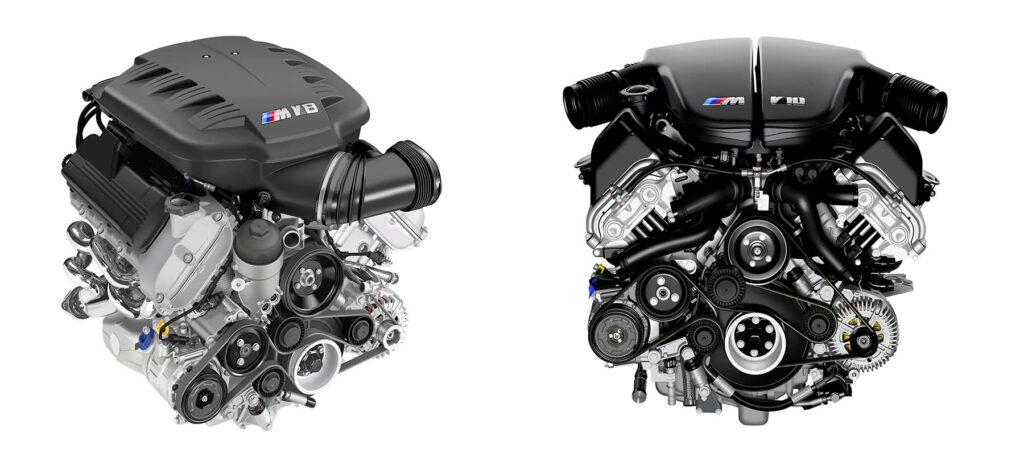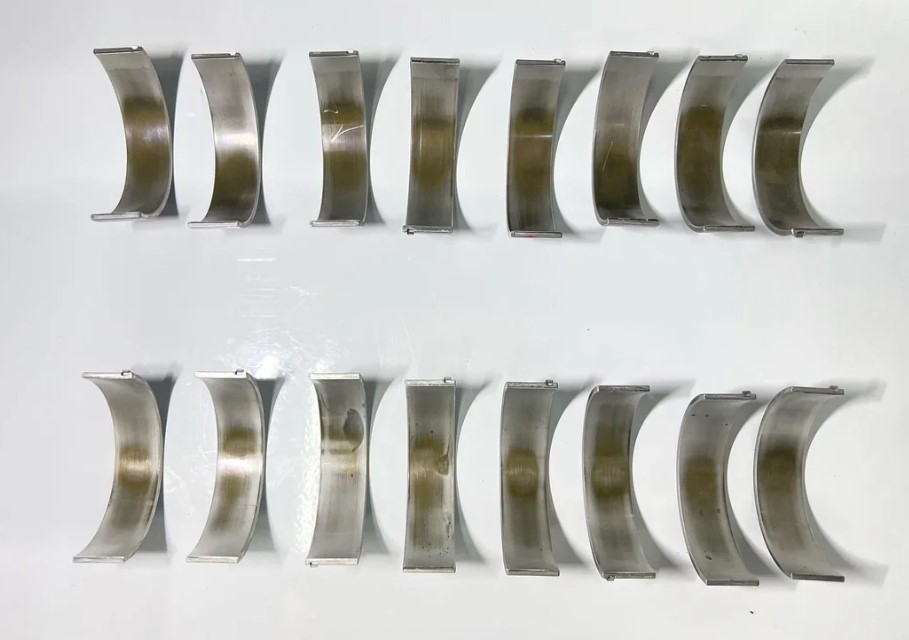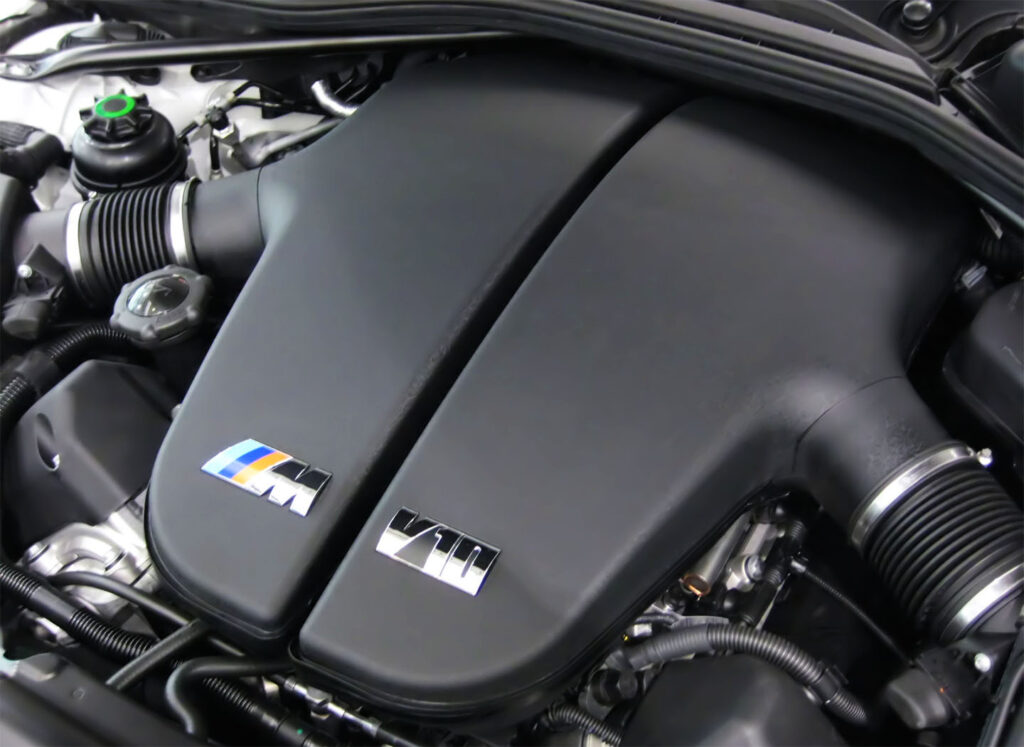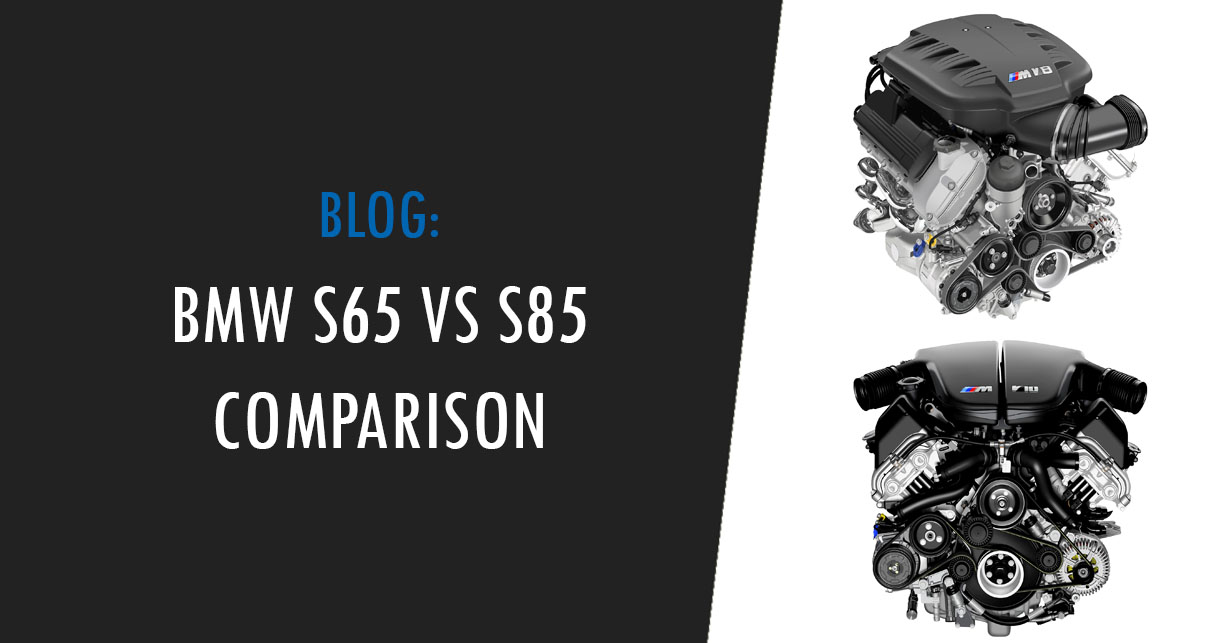When it comes to iconic BMW engines, the S65 V8 and the S85 V10 stand out as some of the best BMW M engines ever made.
With their naturally-aspirated designs and exceptional sound, both engines have become legendary high-revving monsters in the automotive world.
Both of these are engines that share no parts with regular production BMW engines. The S65 is loosely based on the S85. With a unique and exotic exhaust note and linear powerbands, these two iconic BMW M engines are the last non-turbo M engines.
Let’s delve into a detailed comparison of the S65 vs. the S85.
BMW S65 vs. S85 Specifications

| S65B40 | S85B50 | |
|---|---|---|
| Configuration | 90° naturally-aspirated V8 | 90° naturally-aspirated V10 |
| Horsepower | 414 hp @ 8,300 RPM | 500 hp @ 7,500 RPM |
| Torque | 295 lb⋅ft @ 3,900 RPM | 384 lb⋅ft @ 6,100 RPM |
| Record Horsepower | ~1,000 whp | ~1,300 whp |
| Displacement | 3,999 cc | 4,999 cc |
| Compression Ratio | 12.0:1 | 12.0:1 |
| Internals | Forged steel crankshaft, steel rods, cast aluminum pistons | Forged steel crankshaft, steel rods, cast aluminum pistons |
| Block Material | Aluminum | Aluminum |
| Bore & Stroke | 92 mm x 75.2 mm | 92 mm x 75.2 mm |
| Redline | 8,400 RPM | 8,250 RPM |
S65 vs. S85 Horsepower & Torque
In terms of power and torque, the S85 V10 engine found in the E60 M5 takes the lead. With an output of 500 horsepower and 384 lb-ft of torque, it surpasses the S65 V8 engine found in the E90/E92 M3, which offers 414 horsepower and 295 lb-ft of torque (450 horsepower and 325 lb-ft in the M3 GTS).
The S85 clearly boasts impressive performance figures, making it the more powerful unit from the factory. In fact, it held the title of the most powerful BMW engine when it was introduced in 2005.
The S85 outputs more horsepower & torque than the S65
The S85 offers around 50-70hp more than the S65 from stock while torque is also in favor of the S85 by 25-89lb-ft. The V10 is a superior free-revving engine, but maximum power is reached at 6,100rpm which means that you need to rev it quite high. On the other hand, the S65 reaches peak power at 4,000rpm.
Both engines are high-revving and naturally aspirated which means that both offer a linear powerband and are fairly consistent throughout the rev range.
Daily driving is also a breeze with both, but the S65 is a better daily driver as it produces more torque down low in the RPM range.
S65 vs. S85 Tuning & Mods
These engines aren’t as easily tunable as newer turbocharged BMW engines. It’s not as easy to significantly upgrade their power output without resorting to forced induction kits.
You can increase the power of the S65 by 10-20 hp with a simple ECU tune. Exhaust system upgrades, a performance intake, and upgraded pulleys can provide further gains of 20-30 horsepower.
The S85 benefits from upgrades such as headers, performance intakes, and upgraded camshafts.
The best performance upgrade for both engines is a supercharger kit.
Installing a supercharger kit on both the S65 and S85 will give you a considerable horsepower and torque bump. This modification is rather expensive but forced induction is the best way to give these naturally-aspirated engines more power.
The BMW S65 has more aftermarket support and there are many mods available for it. The S65 is much more cost-effective to tune and modify.
S65 vs. S85 Reliability: Are these engines reliable?
Both the S65 and the S85 are high-maintenance engines. While they both can stand the test of time with frequent oil changes and keeping an eye on rod bearing wear, the S65 is generally considered to be the more dependable engine out of the two.
Common issues shared by both engines include excessive rod bearing wear and failing throttle actuators. S85-powered cars, however, experience additional issues such as SMG transmission issues, valve cover gasket oil leaks, and problems with the Vanos solenoids.
The S65 is more reliable and will require less maintenance than the S85
S65 ownership is less stressful and much more forgiving. It requires less frequent maintenance and catastrophic failures are relatively rare. It’s closed deck design makes it a strong rotating assembly that can withstand tuning and abuse.
Either way, both will require bearing rod replacements at some point, and you can expect these to run you about $2,000 to $3,000 with labor.

Change the oil every 5,000 miles, replace the rod bearings at around the 80,000-mile mark, and be on top of any issues that arise these two engines may be
S65 vs. S85 Sound: Which engine sounds better?
It’s a really tough choice to choose between these two in regards to sound. Both are big high-revving engines with redlines upwards of 8,000rpm. V8 and V10 engines are deeply rooted in motorsport, meaning that both sound like pieces of motorsport legacy.
The S85 sounds better than the S65
However, if we had to choose, we’d always go for the S85 V10 because the sound of this engine is unique and unlike almost any other road-legal car.
The sounds of a high-revving V10 are hard to match, and the S85 is no exception. When the S85 is over 7,000 RPM, it is nothing short of pure auditory bliss. Its distinct V10 sound is reminiscent of a Formula 1 car and sets it apart from modern BMW engines.
S65 E90/E92 M3 vs. S85 E60 M5
How does the E90 M3 with the S65 compare to the E60 M5 powered by the S85? The E90 M3 is a compact sports sedan/coupe, while the E60 M5 is a large executive sedan. The E90/E92 M3 has a curb weight of around 3,704 pounds (1,680 kg), while the E60 M5 weighs approximately 4,090 pounds (1,855 kg).

The difference in weight is very noticeable, making the E90 M3 significantly more nimble and also transmitting more road feel to the driver. The E60 M5 is big in comparison, but its steering is precise and cornering is planted as well.
The E90 M3 has better transmission options and a more engaging driving feel
The E90 M3 is available with either a six-speed manual transmission or a seven-speed DCT. The E60 M5, on the other hand, is equipped with a seven-speed single-clutch automated manual transmission or SMG (Sequential Manual Gearbox) or a manual transmission.
Out of the transmission options, the S65 of the E90 M3 paired with the DCT makes for a fantastic combination. The SMG of the E60 M5 is clunky and sluggish, and manuals are very hard to find.
Conclusion: Which engine is better?
Both the S65 V8 and S85 V10 engines hold a special place in BMW’s lineup and are legendary in their regard.
Although they can be tuned, but they will not offer the best performance-for-buck ratio, not nearly as much as newer BMW M turbo inline-6s or turbo V8s, such as the S58 or S63.
The S65 engine is more common, more easily tunable, more reliable, and cheaper to run. The S85 on the other hand is exotic, with very smooth power delivery, and is one of the best-sounding BMW engines of all time.
On the other hand, the S85 V10 engine possesses a certain exotic charm. Its smooth power delivery, incredible sound, and unique character make it truly stand out. If you don’t mind the additional maintenance and potential issues associated with an S85 car,

